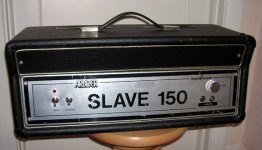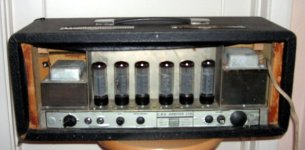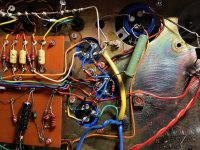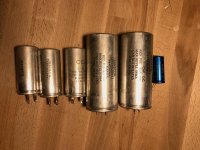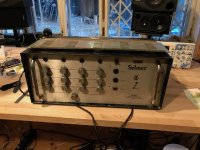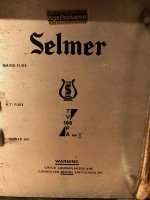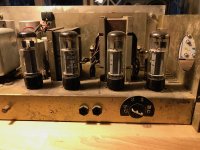I just bought a stock 1969 Selmer TV 100 MKII PA head in original condition including four original Mullard Xf2 EL34s and ECC83 (UK factory)!
The amp is in full working condition (one channel has some noise, I suspect a failing preamp tube) and I will start cleaning and testing it soon.
Since it is not a real beauty or of historic value (?) and it is too heavy and big and loud to use it as an instrument amplifier (I play guitar and also build guitar amps) my first thougths were to use the giant PT plus output tubes to build a PP HIFI amp around them and take the rest of the parts (ie original Mustard caps and OT) to build a slightly less powerfull and big vintage Marshall style guitar amp.
Any ideas, suggestions or objections would be appreciated!
Thanks!!!
Here are a few pictures:
Dropbox - Selmer - Simplify your life
The amp is in full working condition (one channel has some noise, I suspect a failing preamp tube) and I will start cleaning and testing it soon.
Since it is not a real beauty or of historic value (?) and it is too heavy and big and loud to use it as an instrument amplifier (I play guitar and also build guitar amps) my first thougths were to use the giant PT plus output tubes to build a PP HIFI amp around them and take the rest of the parts (ie original Mustard caps and OT) to build a slightly less powerfull and big vintage Marshall style guitar amp.
Any ideas, suggestions or objections would be appreciated!
Thanks!!!
Here are a few pictures:
Dropbox - Selmer - Simplify your life
Fwiw, I can't see much logic in repurposing the PT separate from the OT, or splitting up the amp for starters.
Did you want a stereo hi-fi amp? The monobloc amp as it is could be happily made quite hi-fi, as it has a good architecture and should just need some nous about what to tweak and test.
The OT is huge, so making a 'slightly less powerful' guitar amp, and I presume lighter (as I can't quite see how you would significantly reduce the size such that it would be somehow noticeably more practical to fit or move ) seems a bit strange unless you already have a smaller chassis that would fit the OT.
Did you want a stereo hi-fi amp? The monobloc amp as it is could be happily made quite hi-fi, as it has a good architecture and should just need some nous about what to tweak and test.
The OT is huge, so making a 'slightly less powerful' guitar amp, and I presume lighter (as I can't quite see how you would significantly reduce the size such that it would be somehow noticeably more practical to fit or move ) seems a bit strange unless you already have a smaller chassis that would fit the OT.
Fwiw, I can't see much logic in repurposing the PT separate from the OT, or splitting up the amp for starters.
Did you want a stereo hi-fi amp? The monobloc amp as it is could be happily made quite hi-fi, as it has a good architecture and should just need some nous about what to tweak and test.
The OT is huge, so making a 'slightly less powerful' guitar amp, and I presume lighter (as I can't quite see how you would significantly reduce the size such that it would be somehow noticeably more practical to fit or move ) seems a bit strange unless you already have a smaller chassis that would fit the OT.
Thanks, Trobbins. Yes, I'd like to make a stereo HIFI amp so I need seperate OTs. But your point of the large PT is valid regarding building a "smaller" guitar amp. I was thinking in the lines of a 50W Marshall, but still, the big OT would add quite a lot to the weight of the amp.
If your aim is technical hi-fi, then I'd suggest 'getting all your ducks in a row' first, as it only takes one weak link to either cause you pain, or be the main limiter in performance. Often, a diy valve stereo hi-fi would start with a pair of appropriate OPT's, and work back from there, as the specific output stage and driver's power supply requirements typically dictate the PT needed.
From the other side of the fence, that PA amp offers a lot of modding options just because it has 4 separated input channels. Multiple channels can allow a variety of options, such as series connections for high-gain setups, or for specific effects or effects I/O, or different input stage configs. I had fun doing that with a 100W KT88 PA amp that had 6 ss input channels, and similar configuration to your Selmer, and have a part converted a 200W PA of somewhat similar 5-channel input with slider pots across most of the front face.
From the other side of the fence, that PA amp offers a lot of modding options just because it has 4 separated input channels. Multiple channels can allow a variety of options, such as series connections for high-gain setups, or for specific effects or effects I/O, or different input stage configs. I had fun doing that with a 100W KT88 PA amp that had 6 ss input channels, and similar configuration to your Selmer, and have a part converted a 200W PA of somewhat similar 5-channel input with slider pots across most of the front face.
Last edited:
Thanks again for your input. I‘ll probably just try to get it in proper shape by cleaning and then checking components to see if the filter caps are still good.
Then I can still decide what to do with it.
I just thought those Mullard El34s would be perfect for a PP Hifi design. Maybe I‘ll look for proper OTs for these and then go from there leaving the head ad it is but with new production tubes.
Then I can still decide what to do with it.
I just thought those Mullard El34s would be perfect for a PP Hifi design. Maybe I‘ll look for proper OTs for these and then go from there leaving the head ad it is but with new production tubes.
I guess there is hi-fi and hi-fi. If you make your amp then it will always sound good, and if you swap parts for more expensive parts then it will sound better - the first rule of enjoying hi-fi if you have money.
One comment is that there can be a lot of variation with output stage distortion depending on the tubes and how well matched they are. Just because they are EL34 from some manufacturer and some vintage doesn't necessarily mean they will have lower distortion than from another manufacturer, even if well matched - there is a lot of inherent variation. Tube rolling and having the measurement setup for the amp you have is pretty much the only way to appreciate how much difference there can be in raw distortion, imho.
One comment is that there can be a lot of variation with output stage distortion depending on the tubes and how well matched they are. Just because they are EL34 from some manufacturer and some vintage doesn't necessarily mean they will have lower distortion than from another manufacturer, even if well matched - there is a lot of inherent variation. Tube rolling and having the measurement setup for the amp you have is pretty much the only way to appreciate how much difference there can be in raw distortion, imho.
I would start by checking the emission of each EL34 tube. The getter look tired, as usual on unrestored PA amplifiers that once were on commercial service. They often are very dependable, so they were put aside and forgotten only when the required new tubes became expensive/cumbersome to source. The chassis is a good one. A new front panel plus a good cleaning/polishing may be the only required action if you plan to rebuild the amplifier as stereo. Hunts capacitors have a bad reputation and it would be wise to replace them all.
I used two of these 100W Selmers in a disco set-up in the mid 70s. They were sweet sounding and virtually indestructable compared to the transistorised amps of the time. They are worth a bob or two here in the UK if in good working order. Selmer Amplifiers 1968 to 1969
Just saw your reply! Yes, it had a great sound for its day.That must have been some cool Disco.
Unlike your one, my Selmers came in Tolex covered wooden enclosures, but looked the same under the skin.
I graduated to two Arbiter slave amps whose six EL34's apiece provided even more floor filling power!
As a valve lover, I'm sure you'll drool over the attached images!
Attachments
So I replaced the powersupply filter caps and bias filter cap (just a safety measure), cleaned the tubesockets and fired it up slowly with a variac yesterday. The voltages all checked out close to the schematic. Had only tiome for a short checkup, but everthing works fine, the Mullards are all still sounding good!

The treble tone control of the first channel does not do a lot, I will check the caps later...and also the bias of the EL34s... (Maybe I will add a bias pot.)

The treble tone control of the first channel does not do a lot, I will check the caps later...and also the bias of the EL34s... (Maybe I will add a bias pot.)
An externally hosted image should be here but it was not working when we last tested it.
An externally hosted image should be here but it was not working when we last tested it.
An externally hosted image should be here but it was not working when we last tested it.
An externally hosted image should be here but it was not working when we last tested it.
Last edited:
Here you go...
Attachments
I took some measurements, the EL34 plate voltages are a bit higher than in the schematic (460VDC), the bias supply voltage is -45VDC (-34 in the schematic), so it is biased pretty cold. The other voltages are almost spot on.
Unfortunately the EL34s are not in good shape, I first measured the bias through the OT primary resistance/voltage drop and got very low values. I thought I made some mistake and took out a bias probe.
I got 8/11/0!/17mV drop (through 1 Ohm resistor) readings on the powertubes.
With 460V on the plates I get 3,6/5,6/0/7,82W from the tubes. So only about 15W! Strangely, it sounds much stronger and louder than that, but that may be because of the big iron.
I have ordered a quad of new EL34s, so I will see if the original tubes are really on their last breath when those arrive...
Unfortunately the EL34s are not in good shape, I first measured the bias through the OT primary resistance/voltage drop and got very low values. I thought I made some mistake and took out a bias probe.
I got 8/11/0!/17mV drop (through 1 Ohm resistor) readings on the powertubes.
With 460V on the plates I get 3,6/5,6/0/7,82W from the tubes. So only about 15W! Strangely, it sounds much stronger and louder than that, but that may be because of the big iron.
I have ordered a quad of new EL34s, so I will see if the original tubes are really on their last breath when those arrive...
Cool project. 
If the bias is too negative, it could be some components are out of spec.
I'd change it to adjustable bias anyways, preferably individual or per pair so you can dial in a better idle current.
By the way, the total displayed heat isn't a measure for the max output power.
You can bias them all the way in class B with no idle current at all and still get 100W output power.
If the bias is too negative, it could be some components are out of spec.
I'd change it to adjustable bias anyways, preferably individual or per pair so you can dial in a better idle current.
By the way, the total displayed heat isn't a measure for the max output power.
You can bias them all the way in class B with no idle current at all and still get 100W output power.
Cool project.
If the bias is too negative, it could be some components are out of spec.
I'd change it to adjustable bias anyways, preferably individual or per pair so you can dial in a better idle current.
By the way, the total displayed heat isn't a measure for the max output power.
You can bias them all the way in class B with no idle current at all and still get 100W output power.
Good points. I just never had a case before that a powertube had no idle current at all gong through it.
I will probably first check the resistors in the bias supply and then try lower the resistance before putting in a bias control.
- Status
- This old topic is closed. If you want to reopen this topic, contact a moderator using the "Report Post" button.
- Home
- Live Sound
- Instruments and Amps
- 1969 Selmer PA head with stock Mullard EL34s & Ecc83s: What would you do with it?
 Moved to Instruments & Amps
Moved to Instruments & Amps